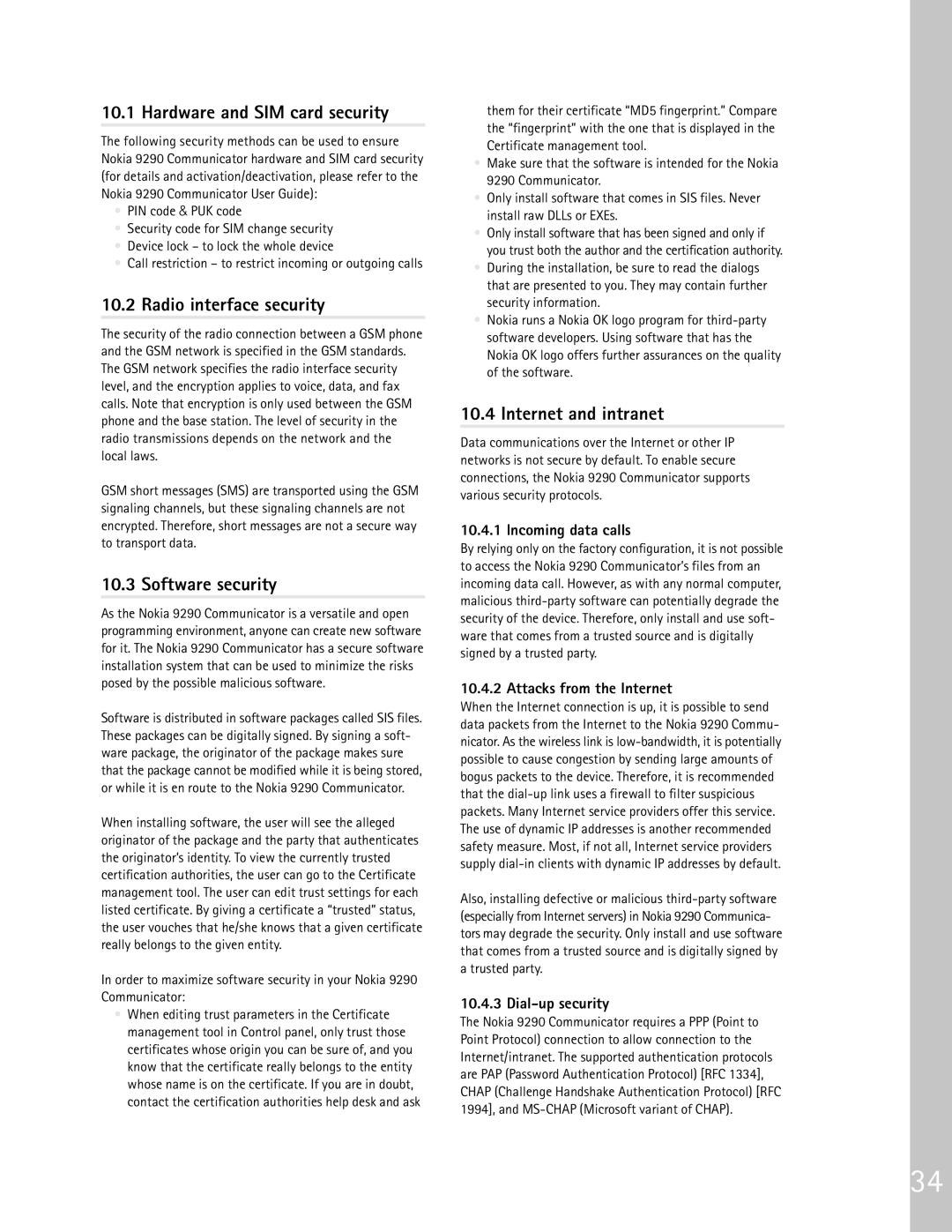10.1 Hardware and SIM card security
The following security methods can be used to ensure Nokia 9290 Communicator hardware and SIM card security (for details and activation/deactivation, please refer to the Nokia 9290 Communicator User Guide):
•PIN code & PUK code
•Security code for SIM change security
•Device lock – to lock the whole device
•Call restriction – to restrict incoming or outgoing calls
10.2 Radio interface security
The security of the radio connection between a GSM phone and the GSM network is specified in the GSM standards. The GSM network specifies the radio interface security level, and the encryption applies to voice, data, and fax calls. Note that encryption is only used between the GSM phone and the base station. The level of security in the radio transmissions depends on the network and the local laws.
GSM short messages (SMS) are transported using the GSM signaling channels, but these signaling channels are not encrypted. Therefore, short messages are not a secure way to transport data.
10.3 Software security
As the Nokia 9290 Communicator is a versatile and open programming environment, anyone can create new software for it. The Nokia 9290 Communicator has a secure software installation system that can be used to minimize the risks posed by the possible malicious software.
Software is distributed in software packages called SIS files. These packages can be digitally signed. By signing a soft- ware package, the originator of the package makes sure that the package cannot be modified while it is being stored, or while it is en route to the Nokia 9290 Communicator.
When installing software, the user will see the alleged originator of the package and the party that authenticates the originator’s identity. To view the currently trusted certification authorities, the user can go to the Certificate management tool. The user can edit trust settings for each listed certificate. By giving a certificate a “trusted” status, the user vouches that he/she knows that a given certificate really belongs to the given entity.
In order to maximize software security in your Nokia 9290 Communicator:
•When editing trust parameters in the Certificate management tool in Control panel, only trust those certificates whose origin you can be sure of, and you know that the certificate really belongs to the entity whose name is on the certificate. If you are in doubt, contact the certification authorities help desk and ask
them for their certificate “MD5 fingerprint.” Compare the “fingerprint” with the one that is displayed in the Certificate management tool.
•Make sure that the software is intended for the Nokia 9290 Communicator.
•Only install software that comes in SIS files. Never install raw DLLs or EXEs.
•Only install software that has been signed and only if you trust both the author and the certification authority.
•During the installation, be sure to read the dialogs that are presented to you. They may contain further security information.
•Nokia runs a Nokia OK logo program for third-party software developers. Using software that has the Nokia OK logo offers further assurances on the quality of the software.
10.4 Internet and intranet
Data communications over the Internet or other IP networks is not secure by default. To enable secure connections, the Nokia 9290 Communicator supports various security protocols.
10.4.1 Incoming data calls
By relying only on the factory configuration, it is not possible to access the Nokia 9290 Communicator’s files from an incoming data call. However, as with any normal computer, malicious third-party software can potentially degrade the security of the device. Therefore, only install and use soft- ware that comes from a trusted source and is digitally signed by a trusted party.
10.4.2 Attacks from the Internet
When the Internet connection is up, it is possible to send data packets from the Internet to the Nokia 9290 Commu- nicator. As the wireless link is low-bandwidth, it is potentially possible to cause congestion by sending large amounts of bogus packets to the device. Therefore, it is recommended that the dial-up link uses a firewall to filter suspicious packets. Many Internet service providers offer this service. The use of dynamic IP addresses is another recommended safety measure. Most, if not all, Internet service providers supply dial-in clients with dynamic IP addresses by default.
Also, installing defective or malicious third-party software (especially from Internet servers) in Nokia 9290 Communica- tors may degrade the security. Only install and use software that comes from a trusted source and is digitally signed by a trusted party.
10.4.3 Dial-up security
The Nokia 9290 Communicator requires a PPP (Point to Point Protocol) connection to allow connection to the Internet/intranet. The supported authentication protocols are PAP (Password Authentication Protocol) [RFC 1334], CHAP (Challenge Handshake Authentication Protocol) [RFC 1994], and MS-CHAP (Microsoft variant of CHAP).

